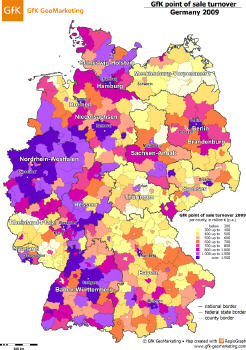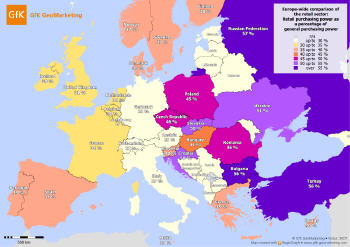Despite the recent global economic downturn, certain sectors of the German retail market are performing well. This is the latest finding by GfK GeoMarketing, a German-based company that offers geomarketing products and services. Geomarketing is a business GIS approach that entails analyzing the place-based component of company and market data using a specialized software application and then illustrating the results on digital maps. This often yields new insights into otherwise hard-to-spot trends.
Uncovering potential with geomarketing
The company's recently released "GfK Point-of-Sale (POS) Turnover for the Retail Trade" study uses a geospatial approach to illuminate valuable information regarding strengths and weaknesses in the German retail market.
The GfK POS Turnover for the Retail Trade dataset contains detailed information on the regional distribution of over-the-counter retail sales in Germany. The data are associated with a map of Germany using the business mapping software RegioGraph 2009 from GfK Marketing and a place-based component - in this case, the postcodes of the retail outlets from which the data were collected. The resulting map delivers immediate information on the location of Germany's retail hotspots, as shown below.
 |
A quick glance at the map shows that urban areas are doing particularly well, with Berlin, Hamburg, D�1⁄4sseldorf, Munich and Stuttgart all posting high point-of-sale retail turnover levels. All but three of the top 15 retail locations are metropolitan areas, which together account for more than �‚¬83.6 billion or 20% of Germany's total POS sales. The map also reveals that counties and metropolitan areas in western Germany are faring better than those in eastern Germany, with the notable exceptions of Berlin and Dresden. The counties of North Rhine-Westphalia and Baden-W�1⁄4rttemberg are two of the strongest with regard to point-of-sale retail turnover.
The study shows there is room for optimism amidst these generally gloomy economic times.
"In light of the expected low inflation rate, retailers will be able to achieve satisfactory results in spite of the currently difficult economic environment," says GfK CEO Professor Klaus L. W�1⁄4bbenhorst, interpreting the results of the study. According to the study's findings, sales are expected to remain stable for over-the-counter retail in 2009, reaching a total volume of �‚¬399 billion.
A geomarketing approach allows companies to precisely pinpoint strengths and weaknesses in their markets. Data on customers, turnover and branch locations can be integrated with market data using a business mapping software such as RegioGraph 2009 and then displayed on maps, giving companies a blueprint for how to achieve greater efficiency and exploit untapped potential. This information is more valuable than ever in difficult economic times.
Metropolitan areas outpacing rural regions
Using the results from the GfK POS Turnover for the Retail Trade study and other analyses, GfK GeoMarketing emphasizes the impressive performance of centralized urban locations in Germany.
"Retail trade is currently benefitting more than ever from centralization," says GfK GeoMarketing real estate and retail expert Olaf Petersen. "The trend toward centralization is driven by the natural desire among consumers to have access to a large variety of retail, gastronomic and service options as well as opportunities to meet up with others amidst a pleasant environment."
Turnover in German city centers grew by more than three percent between 2003 and 2008, while retail floor space increased by seven percent in the same period. The current growth rate in eastern Germany's large cities is particularly striking. Between 2003 and 2008, these areas experienced a turnover growth of 8.8 percent and a retail floor space increase of 26.2 percent. Even so, the GfK POS turnover data for 2009 show that the overall sales volume of eastern Germany's cities still lags significantly behind that of western German cities.
Petersen indicates that city center venues will continue to enjoy "relatively stable market positions and rent levels" in the coming years. He underscores the especially promising growth potential of retail destinations with catchment areas encompassing more than 250,000 inhabitants.
This is very useful information for companies looking to position themselves favorably within the German retail market. Such companies can gain further insight by using this market data in conjunction with their own data and business mapping software in order to create company-specific maps that pinpoint areas of untapped potential.
Obtaining site-specific retail profiles
Petersen's forecast for less central shopping venues is not as optimistic: Centralized retail sites are drawing customers and retailers away from less optimally situated areas as a result of their more varied and attractive qualities. This is a trend apparent across all of Germany's major cities.
Despite this trend, Petersen emphasizes the importance of obtaining the advice of a location expert - another aspect of geomarketing - before committing oneself to a specific location: "There are significant differences between individual locations with regard to the total feasible market potential and other criteria that impact on the success of retail real estate."
Before the suitability of a given retail site can be confirmed, a range of factors need to be evaluated, including the site's catchment area, regional purchasing power, transport accessibility and competing retailers.
A comprehensive geomarketing approach thus entails not only the combined use of software, data and maps, but also the occasional services of a location and real estate expert for the purpose of evaluating site-specific factors that affect business success. GfK GeoMarketing real estate consultants regularly evaluate retail location criteria such as overall turnover, available retail floor space and yield per area through hundreds of annual on-site location and real estate appraisals throughout Europe.
Honing in on specific markets
While cities and conurbations are generally outperforming less populated areas, GfK GeoMarketing's studies indicate that there are some notable exceptions. For example, smaller cities outpace larger urban areas when it comes to sales per inhabitant according to data contained in the GfK POS for the Retail Trade study. In fact, retail sales in these less populous cities are forecasted to exceed the local purchasing power in 2009. This is explained by the fact that such locations serve as retail hubs, drawing large numbers of consumers from outlying regions. As such, they are attractive venues for retailers and investors. The Bavarian city of Straubing leads the pack in this category, generating �‚¬11,830 per inhabitant - almost two-and-a-half times the national average of �‚¬4,850. Berlin, the German city with the highest absolute POS turnover, ranks only 122nd with regard to sales per inhabitant.
These and other insights are easily obtained through a geomarketing approach. Various market datasets can be compared and then illustrated to reveal the best way forward for companies given their specific markets, target groups and locations. If, as in the previous example, a company wants to identify mid-sized cities with particularly high retail drawing power, POS turnover figures can be cross-referenced with regional purchasing power data. Regions in which sales turnover significantly exceeds local purchasing power indicate retail destinations that attract customers from a broad geographic area. These locations can be quickly illustrated on maps, allowing companies to structure their sales and marketing activities accordingly.
Identifying sustainable investments in uncertain times
In addition to providing insights on broad market and turnover trends, geomarketing can identify specific retail venue types that are performing well by comparing point-of-sale turnover data and then illustrating the results.
Shopping centers have emerged as an especially promising retail venue according to an article recently published by Manuel Jahn, a GfK GeoMarketing expert on investors and financers.
"Amidst the tumultuous waters of the present crisis, owners, banks and tenants can look to one particular investment area that continues to chart a steady course: the German shopping center," says Jahn, pointing out that rental income and retail turnover have been growing by one to one-and-a-half percent in good shopping center portfolios.
Despite decreases in European retail spending, Jahn is optimistic regarding the outlook for German shopping centers. While Spanish, Polish and Turkish shoppers spend between 35 and 56 percent of their disposable income in retail venues during prosperous periods, the notoriously frugal German consumers devote only around 28 percent of their disposable income to retail expenditures. This discrepancy is clearly identifiable on GfK GeoMarketing's recently created map depicting the Europe-wide percentage of general purchasing power devoted to retail spending.
 |
"While the once enthusiastic shoppers in many other European countries are now forced to tighten their belts, German consumers have long since already done so, meaning that further cuts in spending among Germans are not likely," Jahn explains.
Additionally, the substantial government benefits enjoyed by Germans - in contrast with many other European countries - help to guard against a steep decline in consumption.
Even so, Jahn stresses the importance of arranging for a professional on-site evaluation of a given real estate object before making an investment. An analysis that focuses solely on market trends doesn't always shed light on site-specific criteria that can also contribute to the success or failure of a retail venue.
Better business decisions through geomarketing
Companies increasingly regard geomarketing as an indispensible planning and decision making tool. By incorporating relevant market data and their own data into a business mapping software, companies can produce individuated cartographic portraits of their markets. This frequently reveals trends and relationships in the data that previously went unnoticed, allowing companies to position themselves more profitably.